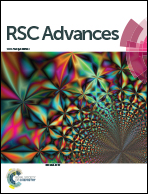A ZnO–CNT nanocomposite based electrochemical DNA biosensor for meningitis detection
Abstract
A zinc oxide (ZnO) and multiwalled carbon nanotube (CNT) based nanocomposite matrix has been fabricated onto indium tin oxide (ITO) coated glass (ITO/glass) platform via. A chemical route. The thiolated oligonucleotides probe sequence consisting of 23 bases (single-stranded DNA) has been immobilized onto the ZnO–CNT/ITO electrode using a physical adsorption technique. The fabricated bioelectrode (ssDNA/ZnO–CNT/ITO) is used to specifically detect N. meningitidis with a high sensitivity of 20.20 μA per decade and 45 s of hybridization time by differential pulse voltammetry (DPV) using methylene blue as an electroactive indicator. The prepared DNA biosensor exhibits linearity in a wide range (5–180 ng μl−1). The electrochemical impedance response behaviour of the ssDNA/ZnO–CNT/ITO bioelectrode with an increase in the target DNA concentration has also been studied using [Fe(CN)6]3−/4− as the hybridization indicator. The results indicate the possibility of fabricating a handheld device for meningitis detection at an early stage.


 Please wait while we load your content...
Please wait while we load your content...